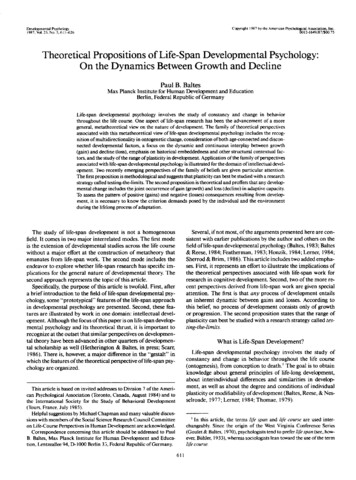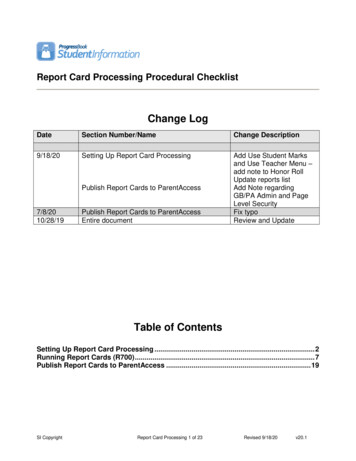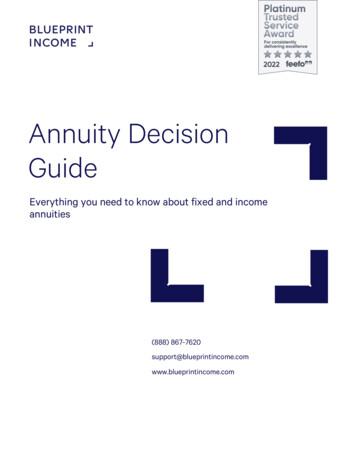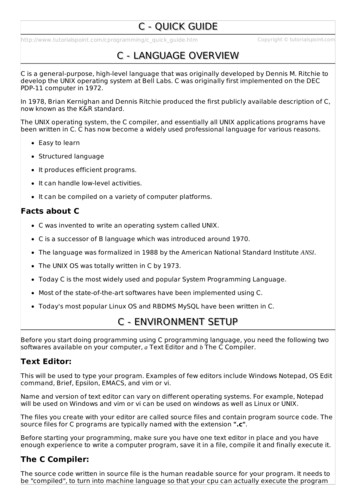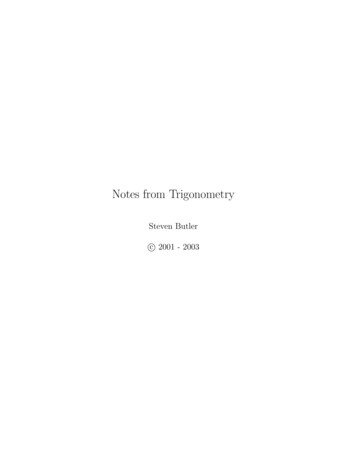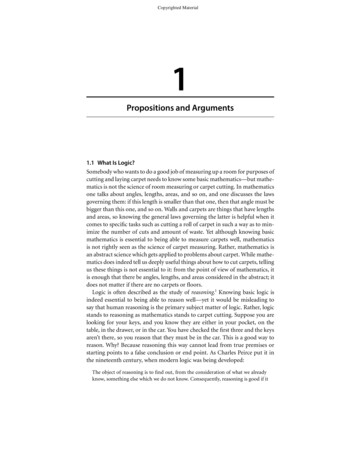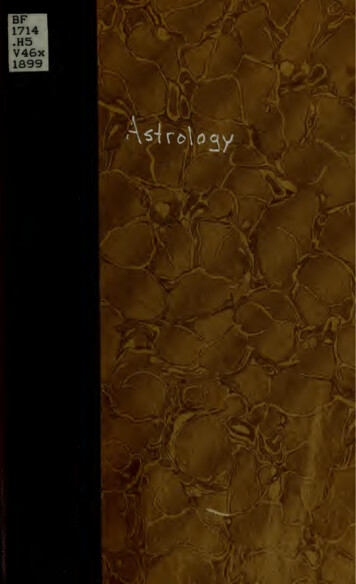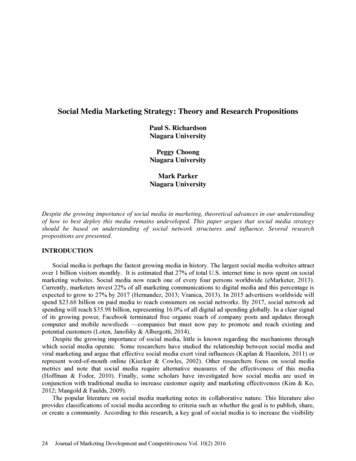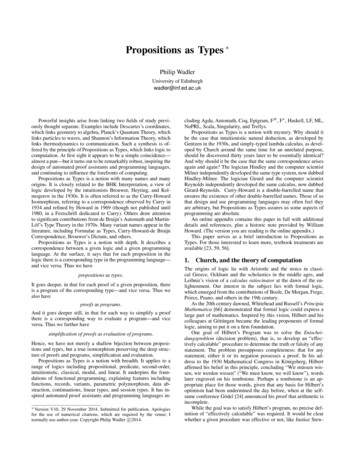
Transcription
Propositions as Types Philip WadlerUniversity of Edinburghwadler@inf.ed.ac.ukPowerful insights arise from linking two fields of study previously thought separate. Examples include Descartes’s coordinates,which links geometry to algebra, Planck’s Quantum Theory, whichlinks particles to waves, and Shannon’s Information Theory, whichlinks thermodynamics to communication. Such a synthesis is offered by the principle of Propositions as Types, which links logic tocomputation. At first sight it appears to be a simple coincidence—almost a pun—but it turns out to be remarkably robust, inspiring thedesign of automated proof assistants and programming languages,and continuing to influence the forefronts of computing.Propositions as Types is a notion with many names and manyorigins. It is closely related to the BHK Interpretation, a view oflogic developed by the intuitionists Brouwer, Heyting, and Kolmogorov in the 1930s. It is often referred to as the Curry-HowardIsomorphism, referring to a correspondence observed by Curry in1934 and refined by Howard in 1969 (though not published until1980, in a Festschrift dedicated to Curry). Others draw attentionto significant contributions from de Bruijn’s Automath and MartinLöf’s Type Theory in the 1970s. Many variant names appear in theliterature, including Formulae as Types, Curry-Howard-de BruijnCorrespondence, Brouwer’s Dictum, and others.Propositions as Types is a notion with depth. It describes acorrespondence between a given logic and a given programminglanguage. At the surface, it says that for each proposition in thelogic there is a corresponding type in the programming language—and vice versa. Thus we havepropositions as types.It goes deeper, in that for each proof of a given proposition, thereis a program of the corresponding type—and vice versa. Thus wealso haveproofs as programs.And it goes deeper still, in that for each way to simplify a proofthere is a corresponding way to evaluate a program—and viceversa. Thus we further havesimplification of proofs as evaluation of programs.Hence, we have not merely a shallow bijection between propositions and types, but a true isomorphism preserving the deep structure of proofs and programs, simplification and evaluation.Propositions as Types is a notion with breadth. It applies to arange of logics including propositional, predicate, second-order,intuitionistic, classical, modal, and linear. It underpins the foundations of functional programming, explaining features includingfunctions, records, variants, parametric polymorphism, data abstraction, continuations, linear types, and session types. It has inspired automated proof assistants and programming languages in VersionV10, 29 November 2014. Submitted for publication. Apologiesfor the use of numerical citations, which are required by the venue; Inormally use author-year. Copyright Philip Wadler c 2014.cluding Agda, Automath, Coq, Epigram, F# , F? , Haskell, LF, ML,NuPRL, Scala, Singularity, and Trellys.Propositions as Types is a notion with mystery. Why should itbe the case that intuitionistic natural deduction, as developed byGentzen in the 1930s, and simply-typed lambda calculus, as developed by Church around the same time for an unrelated purpose,should be discovered thirty years later to be essentially identical?And why should it be the case that the same correspondence arisesagain and again? The logician Hindley and the computer scientistMilner independently developed the same type system, now dubbedHindley-Milner. The logician Girard and the computer scientistReynolds independently developed the same calculus, now dubbedGirard-Reynolds. Curry-Howard is a double-barrelled name thatensures the existence of other double-barrelled names. Those of usthat design and use programming languages may often feel theyare arbitrary, but Propositions as Types assures us some aspects ofprogramming are absolute.An online appendix contains this paper in full with additionaldetails and references, plus a historic note provided by WilliamHoward. (The version you are reading is the online appendix.)This paper serves as a brief introduction to Propositions asTypes. For those interested to learn more, textbook treatments areavailable [23, 59, 56].1.Church, and the theory of computationThe origins of logic lie with Aristotle and the stoics in classical Greece, Ockham and the scholastics in the middle ages, andLeibniz’s vision of a calculus ratiocinator at the dawn of the enlightenment. Our interest in the subject lies with formal logic,which emerged from the contributions of Boole, De Morgan, Frege,Peirce, Peano, and others in the 19th century.As the 20th century dawned, Whitehead and Russell’s PrincipiaMathematica [66] demonstrated that formal logic could express alarge part of mathematics. Inspired by this vision, Hilbert and hiscolleagues at Göttingen became the leading proponents of formallogic, aiming to put it on a firm foundation.One goal of Hilbert’s Program was to solve the Entscheidungsproblem (decision problem), that is, to develop an “effectively calculable” procedure to determine the truth or falsity of anystatement. The problem presupposes completeness: that for anystatement, either it or its negation possesses a proof. In his address to the 1930 Mathematical Congress in Königsberg, Hilbertaffirmed his belief in this principle, concluding “Wir müssen wissen, wir werden wissen” (“We must know, we will know”), wordslater engraved on his tombstone. Perhaps a tombstone is an appropriate place for those words, given that any basis for Hilbert’soptimism had been undermined the day before, when at the selfsame conference Gödel [24] announced his proof that arithmetic isincomplete.While the goal was to satisfy Hilbert’s program, no precise definition of “effectively calculable” was required. It would be clearwhether a given procedure was effective or not, like Justice Stew-
art’s characterisation of obscenity, “I know it when I see it”. Butto show the Entscheidungsproblem undecidable required a formaldefinition of “effectively calculable”.One can find allusions to the concept of algorithm in the workof Euclid and, eponymously, al-Khwarizmi, but the concept wasonly formalised in the 20th century, and then simultaneously received three independent definitions by logicians. Like buses: youwait two thousand years for a definition of “effectively calculable”,and then three come along at once. The three were lambda calculus, published 1936 by Alonzo Church [9], recursive functions, proposed by Gödel at lectures in Princeton in 1934 and published 1936by Stephen Kleene [35], and Turing machines, published 1937 byAlan Turing [60].Lambda calculus was introduced by Church at Princeton, andfurther developed by his students Rosser and Kleene. At this time,Princeton rivalled Göttingen as a centre for the study of logic. TheInstitute for Advanced Study was co-located with the mathematicsdepartment in Fine Hall. In 1933, Einstein and von Neumann joinedthe Institute, and Gödel arrived for a visit.Logicians have long been concerned with the idea of function.Lambda calculus provides a concise notation for functions, including “first-class” functions that may appear as arguments or resultsof other functions. It is remarkably compact, containing only threeconstructs: variables, function abstraction, and function application. Church [7] at first introduced lambda calculus as a way to define notations for logical formulas (almost like a macro language)in a new presentation of logic. All forms of bound variable couldbe subsumed to lambda binding. (For instance, instead of x. A[x],Church wrote Σ(λx. A[x]).) However, it was later discovered byKleene and Rosser [38] that Church’s system was inconsistent. Bythis time, Church and his students had realised that the system wasof independent interest. Church had foreseen this possibility in hisfirst paper on the subject, where he wrote “There may, indeed, beother applications of the system than its use as a logic.”Church discovered a way of encoding numbers as terms oflambda calculus. The number n is represented by a function thataccepts a function f and a value x, and applies the function to thevalue n times. (For instance, three is λf. λx. f (f (f (x))).) Withthis representation, it is easy to encode lambda terms that can add ormultiply, but it was not clear how to encode the predecessor function, which finds the number one less than a given number. Oneday in the dentist’s office, Kleene suddenly saw how to define predecessor [34]. When Kleene brought the result to his supervisor,Church confided that he had nearly convinced himself that representing predecessor in lambda calculus was impossible. Once thishurdle was overcome, Church and his students soon became convinced that any “effectively calculable” function of numbers couldbe represented by a term in the lambda calculus.Church proposed λ-definability as the definition of “effectively calculable”, what we now know as Church’s Thesis, anddemonstrated that there was a problem whose solution was not λdefinable, that of determining whether a given λ-term has a normalform, what we now know as the Halting Problem [9]. A year later,he demonstrated there was no λ-definable solution to the Entscheidungsproblem [8].In 1933, Gödel arrived for a visit at Princeton. He was unconvinced by Church’s contention that every effectively calculable function was λ-definable. Church responded by offering thatif Gödel would propose a different definition, then Church would“undertake to prove it was included in λ-definability”. In a series oflectures at Princeton in 1934, based on a suggestion of Herbrand,Gödel proposed what came to be known as “general recursive functions” as his candidate for effective calculability. Kleene took notesand published the definition [35]. Church and his students soon determined that the two definitions are equivalent: every general re-cursive function is λ-definable, and vice-versa. The proof was outlined by Church [8] and published in detail by Kleene [36]. Ratherthan mollifying Gödel, this result caused him to doubt that his owndefinition was correct! Things stood at an impasse.Meanwhile, at Cambridge, Alan Turing, a student of Max Newman, independently formulated his own notion of “effectively calculable” in the form of what we now call a Turing Machine, andused this to show the Entscheidungsproblem undecidable. Beforethe paper was published, Newman was dismayed to discover thatTuring had been scooped by Church. However, Turing’s approachwas sufficiently different from Church’s to merit independent publication. Turing hastily added an appendix sketching the equivalence of λ-definability to his machines, and his paper [60] appearedin print a year after Church’s, when Turing was 23. Newman arranged for Turing to travel to Princeton, where he completed a doctorate under Church’s supervision.Turing’s most significant difference from Church was not inlogic or mathematics but in philosophy. Whereas Church merelypresented the definition of λ-definability and baldly claimed that itcorresponded to effective calculability, Turing undertook an analysis of the capabilities of a “computer”—at this time, the term referred to a human performing a computation assisted by paper andpencil. Turing argued that the number of symbols must be finite (forif infinite, some symbols would be arbitrarily close to each otherand undistinguishable), that the number of states of mind must befinite (for the same reason), and that the number of symbols underconsideration at one moment must be bounded (“We cannot tell at aglance whether 9999999999999999 and 999999999999999 are thesame”). Later, Gandy [18] would point out that Turing’s argumentamounts to a theorem asserting that any computation a human withpaper and pencil can perform can also be performed by a TuringMachine. It was Turing’s argument that finally convinced Gödel;since λ-definability, recursive functions, and Turing machines hadbeen proved equivalent, he now accepted that all three defined “effectively calculable”.As mentioned, Church’s first use of lambda calculus was to encode formulas of logic, but this had to be abandoned because it ledto inconsistency. The failure arose for a reason related to Russell’sparadox, namely that the system allowed a predicate to act on itself,and so Church adapted a solution similar to Russell’s, that of classifying terms according to types. Church’s simply-typed lambdacalculus ruled out self-application, permitting lambda calculus tosupport a consistent logical formulation [10].Whereas self-application in Russell’s logic leads to paradox,self-application in Church’s untyped lambda calculus leads tonon-terminating computations. Conversely, Church’s simply-typedlambda calculus guarantees every term has a normal form, that is,corresponds to a computation that halts.The two applications of lambda calculus, to represent computation and to represent logic, are in a sense mutually exclusive. If anotion of computation is powerful enough to represent any effectively calculable procedure, then that notion is not powerful enoughto solve its own Halting Problem: there is no effectively calculable procedure to determine whether a given effectively calculableprocedure terminates. However, the consistency of Church’s logicbased on simply-typed lambda calculus depends on every term having a normal form.Untyped lambda calculus or typed lambda calculus with a construct for general recursion (sometimes called a fixpoint operator)permits the definition of any effectively computable function, buthave a Halting Problem that is unsolvable. Typed lambda calculiwithout a construct for general recursion have a Halting Problemthat is trivial—every program halts!—but cannot define some effectively computable functions. Both kinds of calculus have theiruses, depending on the intended application.
As well as fundamental contributions to programming languages, Church also made early contributions to hardware verification and model checking, as described by Vardi [62].2.Gentzen, and the theory of proofA second goal of Hilbert’s program was to establish the consistencyof various logics. If a logic is inconsistent, then it can derive anyformula, rendering it useless.In 1935, at the age of 25, Gerhard Gentzen [20] introduced notone but two new formulations of logic, natural deduction and sequent calculus, which became established as the two major systemsfor formulating a logic, and remain so to this day. He showed howto normalise proofs to ensure they were not “roundabout”, yieldinga new proof of the consistency of Hilbert’s system. And, to top itoff, to match the use of the symbol for the existential quantification introduced by Peano, Gentzen introduced the symbol todenote universal quantification. He wrote implication as A B (ifA holds then B holds), conjunction as A & B (both A and B hold),and disjunction as A B (at least one of A or B holds).Gentzen’s insight was that proof rules should come in pairs, afeature not present in earlier systems such as Hilbert’s. In naturaldeduction, these are introduction and elimination pairs. An introduction rule specifies under what circumstances one may assert aformula with a logical connective (for instance, to prove A B,one may assume A and then must prove B), while the corresponding elimination rule shows how to use that logical connective (forinstance, from a proof of A B and a proof of A one may deduce B, a property dubbed modus ponens in the middle ages). AsGentzen notes, “The introductions represent, as it were, the ‘definitions’ of the symbols concerned, and the eliminations are no more,in the final analysis, than the consequences of these definitions.”A consequence of this insight was that any proof could benormalised to one that is not “roundabout”, where “no conceptsenter into the proof other than those contained in the final result”.For example, in a normalised proof of the formula A & B, the onlyformulas that may appear are itself and its subformulas, A and B,and the subformulas of A and B themselves. No other formula,such as (B & A) (A & B) or A B, may appear; this iscalled the Subformula Principle. An immediate consequence wasconsistency. It is a contradiction to prove false, written f. The onlyway to derive a contradiction is to prove, say, both A f and Afor some formula A. But given such a proof, one could normaliseit to one containing only subformulas of its conclusion, f. But fhas no subformulas! It is like the old saw, “What part of no don’tyou understand?” Logicians became interested in normalisation ofproofs because of its role in establishing consistency.Gentzen preferred the system of Natural Deduction because itwas, in his view, more natural. He introduced Sequent Calculusmainly as a technical device for proving the Subformula Principle,though it has independent interest.Sequent Calculus has two key properties. First, every proof inNatural Deduction can be converted to a proof in Sequent Calculus,and conversely, so the two systems are equivalent. Second, unlikeNatural Deduction, every rule save one has the property that its hypotheses only involve subformulas of those that appear in its conclusion. The one exception, the Cut rule, can always be removed bya process called Cut Elimination. Hence every proof had an equivalent normal form satisfying the Subformula Principle. Gentzen’smain interest in Sequent Calculus was to prove the SubformulaPrinciple, although Sequent Calculus has features of independentinterest, such as providing a more symmetric presentation of classical logic, and today researchers often use formulations closer toSequent Calculus than to Natural Deduction.It is an irony that Gentzen was required to introduce SequentCalculus in order to prove the Subformula Principle for NaturalDeduction. He needed a roundabout proof to show the absence ofroundabout proofs! Later, in 1965, Prawitz showed how to provethe Subformula Principle directly, by introducing a way to simplifyNatural Deduction proofs; and this set the ground for Howard’swork described in the next section.3.Propositions as TypesIn 1934, Curry observed a curious fact, relating a theory of functions to a theory of implication [13]. Every type of a function(A B) could be read as a proposition (A B), and under thisreading the type of any given function would always correspond toa provable proposition. Conversely, for every provable propositionthere was a function with the corresponding type. Subsequently,Curry and Feys [14] extended the correspondence from not merelytypes and propositions to also include term and proofs, and to hintat the relation between evaluation of terms and simplification ofproofs.In 1969, Howard circulated a xeroxed manuscript [32]. It wasnot published until 1980, where it appeared in a Festschrift dedicated to Curry. Motivated by Curry’s observation, Howard pointedout that there is a similar correspondence between natural deduction, on the one hand, and simply-typed lambda calculus, on theother, and he made explicit the third and deepest level of the correspondence as described in the introduction, that simplification ofproofs corresponds to evaluation of programs. Howard showed thecorrespondence extends to the other logical connectives, conjunction and disjunction, by extending his lambda calculus with constructs that represent pairs and disjoint sums. Just as proof rulescome in introduction and elimination pairs, so do typing rules: introduction rules correspond to ways to define or construct a valueof the given type, and elimination rules correspond to ways to useor deconstruct values of the given type.We can describe Howard’s observation as follows: Conjunction A & B corresponds to Cartesian product A B,that is, a record with two fields, also known as a pair. A proofof the proposition A & B consists of a proof of A and a proof ofB. Similarly, a value of type A B consists of a value of typeA and a value of type B. Disjunction A B corresponds to a disjoint sum A B, thatis, a variant with two alternatives. A proof of the propositionA B consists of either a proof of A or a proof of B, includingan indication of which of the two has been proved. Similarly, avalue of type A B consists of either a value of type A or avalue of type B, including an indication of whether this is a leftor right summand. Implication A B corresponds to function space A B. Aproof of the proposition A B consists of a procedure thatgiven a proof of A yields a proof of B. Similarly, a value oftype A B consists of a function that when applied to a valueof type A returns a value of type B.This reading of proofs goes back to the intuitionists, and is oftencalled the BHK interpretation, named for Brouwer, Heyting, andKolmogorov. Brouwer founded intuitionism [28], and Heyting [29]and Kolmogorov [39] formalised intuitionistic logic, and developedthe interpretation above, in the 1920s and 1930s. Realisability,introduced by Kleene [37] in the 1940s, is based on a similarinterpretation.Given the intuitionistic reading of proofs, it hardly seems surprising that intuitionistic natural deduction and lambda calculusshould correspond so closely. But it wasn’t until Howard that thecorrespondence was laid out clearly, in a way that allowed workinglogicians and computer scientists to put it to use.
Howard’s paper divides into two halves. The first half explains acorrespondence between two well-understood concepts, the propositional connectives &, , on the one hand and the computationaltypes , , on the other hand. The second half extends thisanalogy, and for well-understood concepts from logic proposes newconcepts for types that correspond to them. In particular, Howardproposes that the predicate quantifiers and corresponds to newtypes that we now call dependent types.With the introduction of dependent types, every proof in predicate logic can be represented by a term of a suitable typed lambdacalculus. Mathematicians and computer scientists proposed numerous systems based on this concept, including de Bruijn’s Automath[17], Martin-Löf’s type theory [43], Bates and Constable’s PRLand nuPRL [3], and Coquand and Huet’s Calculus of Constructions[11], which developed into the Coq proof assistant.Applications include CompCert, a certified compiler for the Cprogramming language verified in Coq [41]; a computer-checkedproof of the four-colour theorem also verified in Coq [25]; parts ofthe Ensemble distributed system verified in NuPRL [27, 40]; andtwenty thousand lines of browser plug-ins verified in F? [57].de Bruijn’s work was independent of Howard’s, but Howarddirectly inspired Martin Löf and all the other work listed above.Howard was (justly!) proud of his paper, citing it as one of the twogreat achievements of his career [55].4.Intuitionistic logicIn Gilbert and Sullivan’s The Gondoliers, Casilda is told that as aninfant she was married to the heir of the King of Batavia, but thatdue to a mix-up no one knows which of two individuals, Marco orGiuseppe, is the heir. Alarmed, she wails “Then do you mean to saythat I am married to one of two gondoliers, but it is impossible tosay which?” To which the response is “Without any doubt of anykind whatever.”Logic comes in many varieties, and one distinction is betweenclassical and intuitionistic. Intuitionists, concerned by cavalier assumptions made by some logicians about the nature of infinity, insist upon a constructionist notion of truth. In particular, they insistthat a proof of A B must show which of A or B holds, and hencethey would reject the claim that Casilda is married to Marco orGiuseppe until one of the two was identified as her husband. Perhaps Gilbert and Sullivan anticipated intuitionism, for their story’soutcome is that the heir turns out to be a third individual, Luiz, withwhom Casilda is, conveniently, already in love.Intuitionists also reject the law of the excluded middle, whichasserts A A for every A, since the law gives no clue as towhich of A or A holds. Heyting formalised a variant of Hilbert’sclassical logic that captures the intuitionistic notion of provability.In particular, the law of the excluded middle is provable in Hilbert’slogic, but not in Heyting’s. Further, if the law of the excludedmiddle is added as an axiom to Heyting’s logic, then it becomesequivalent to Hilbert’s. Kolmogorov showed the two logics wereclosely related: he gave a double-negation translation, such that aformula is provable in classical logic if and only if its translation isprovable in intuitionistic logic.Propositions as Types was first formulated for intuitionisticlogic. It is a perfect fit, because in the intuitionist interpretationthe formula A B is provable exactly when one exhibits either aproof of A or a proof of B, so the type corresponding to disjunctionis a disjoint sum.5.Other logics, other computationThe principle of Propositions as Types would be remarkable evenif it applied only to one variant of logic and one variant of compu-tation. How much more remarkable, then, that it applies to a widevariety of logics and of computation.Quantification over propositional variables in second-orderlogic corresponds to type abstraction in second-order lambda calculus. For this reason, the second-order lambda calculus was discovered twice, once by the logician Jean-Yves Girard [21] and onceby the computer scientist John Reynolds [53]. And for the samereason, a similar system that supports principle type inference wasalso discovered twice, once by the logician Roger Hindley [30] andonce by the computer scientist Robin Milner [45]. Building on thecorrespondence, John Mitchell and Gordon Plotkin [46] observedthat existential quantification in second-order logic correspondsprecisely to data abstraction, an idea that now underpins much research in the semantics of programming languages. The design ofgeneric types in Java and C# draws directly upon Girard-Reynolds,while the type systems of functional languages including ML andHaskell are based upon Hindley-Milner. Philosophers might argueas to whether mathematical systems are ‘discovered’ or ‘devised’,but the same system arising in two different contexts argues thathere the correct word is ‘discovered’.Two major variants of logic are intuitionistic and classical.Howard’s original paper observed a correspondence with intuitionistic logic. Not until two decades later was the correspondence extended to also apply to classical logic, when Tim Griffin[26] observed that Peirce’s Law in classical logic provides a typefor the call/cc operator of Scheme. Chet Murthy [49] went on tonote that Kolmogorov and Gödel’s double-negation translation,widely used to relate intuitionistic and classical logic, correspondsto the continuation-passing style transformation widely used bothby semanticists and implementers of lambda calculus. Parigot [50],Curien and Herbelin [12], and Wadler [64] introduced various computational calculi motivated by correspondences to classical logic.Modal logic permits propositions to be labelled as ‘necessarilytrue’ or ‘possibly true’. Clarence Lewis introduced modal logicin 1910, and his 1938 textbook [42] describes five variants, S1–S5. Some claim that each of these variants has an interpretationas a form of computation via Propositions as Types, and a downpayment on this claim is given by an interpretation of S4 as stagedcomputation due to Davies and Pfenning [16], and of S5 as spatiallydistributed computation due to Murphy et al [48].Eugenio Moggi [47] introduced monads as a technique to explain the semantics of important features of programming languages such as state, exceptions, and input-output. Monads becamewidely adopted in the functional language Haskell, and later migrated into other languages, including Clojure, Scala, F#, and C#.Benton, Bierman, and de Paiva [4] observed that monads correspond to yet another modal logic, differing from all of S1–S5.Temporal logic admits distinction between modalities such as‘holds now’, ‘will hold eventually’, and ‘will hold in the next timestep’. Temporal logic was first formalised by Arthur Prior in his1957 text [52], and came to play a major role in the specificationand verification of computing systems, beginning with the work ofAmir Pnueli [51]. Interpretations of temporal logics via Propositions as Types include an application to partial evaluation due toDavies [15], and an application to functional reactive programmingdue to Jeffery [33].In classical, intuitionistic, and modal logic, any hypothesis canbe used an arbitrary number of times—zero, once, or many. Linearlogic, introduced in 1987 by Girard [22], requires that each hypothesis is used exactly once. Linear logic is ‘resource conscious’in that facts may be used up and superseded by other facts, suitingit for reasoning about a world where situations change. From itsinception, linear logic was suspected to apply to problems of importance to computer scientists, and its first publication was not inAnnals of Mathematics but in Theoretical Computer Science. Com-
putational aspects of linear logic are discussed by Abramsky [1]and Wadler [63], among many others, and applications to quantumcomputing are surveyed by Gay [19]. Most recently, Session Types,a way of describing communication protocols introduced by Honda[31], have been related to intuitionistic linear logic by Caires andPfenning [5], and to classical linear logic by Wadler [65].One key to the correspondence between logic and computationis the study of category theory. Both simply-typed lambda calculusand intuitionistic natural deduction correspond to the notion of acartesian closed category [54]. Many extensions of this idea arise,including an exciting strand of work linking categories, computation, linear logic, and quantum physics [2].Vladimir Voevodsky, a winner of the Fields Medal, excitedmuch interest with his rec
consideration at one moment must be bounded ("We cannot tell at a glance whether 9999999999999999 and 999999999999999 are the same"). Later, Gandy [18] would point out that Turing's argument amounts to a theorem asserting that any computation a human with paper and pencil can perform can also be performed by a Turing Machine. It was Turing's argument that finally convinced G odel .
